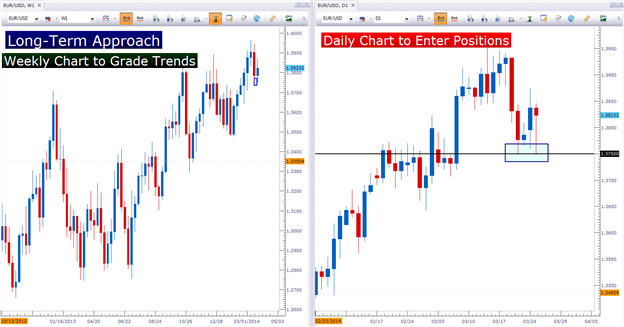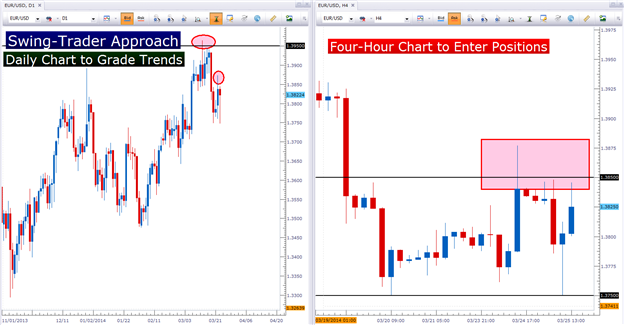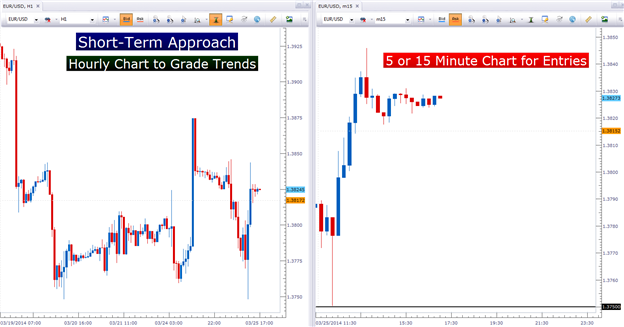Regardless of how great a trader you ever become, you can always get better.
One of the most important aspects of a trader’s success is the approach being utilized to speculate in markets. Sometimes, certain approaches just don’t work for certain traders. Maybe its personality or risk characteristics; or perhaps the approach is just un-workable to begin with.
In this article, we’re going to look at the three most common approaches to speculate in markets, along with tips for which time frames and tools can best serve traders utilizing those approaches. In each of these approaches, we’re going to suggest two time frames for traders to utilize based around the concept of Multiple Time Frame Analysis.
When using multiple time frame analysis, traders will look to use a longer-term chart to grade trends and investigate the general nature of the current technical setup; while utilizing a shorter-term chart to ‘trigger’ or enter positions in consideration of that longer-term setup.
The Long-Term Approach
Optimal Time Frames: Weekly, and Daily Chart
For some reason, many new traders do everything they can to avoid this approach. This is likely because new, uninformed traders think that a longer-term approach means it takes a lot longer to find profitability.
In most cases, this couldn’t be further from the truth.
By many accounts, trading with a shorter-term approach is quite a bit more difficult to do profitably, and it often takes traders considerably longer to develop their strategy to actually find profitability.
There are quite a few reasons for this, but the shorter the term, the less information that goes into each and every candlestick. Variability increases the shorter our outlooks get because we’re adding the limiting factor of time.
There aren’t many successful scalpers that don’t know what to do on the longer-term charts; and in many cases, day-traders are using the longer-term charts to plot their shorter-term strategies.
All new traders should begin with a long-term approach; only getting shorter-term as they see success with a longer-term strategy. This way, as the margin of error increases with shorter-term charts and more volatile information, the trader can dynamically make adjustments to risk and trade management.
Traders utilizing a longer-term approach can look to use the weekly chart to grade trends, and the daily chart to enter into positions.
Longer-Term approaches can look to the weekly chart for grading trends, and the dailychart for entries

Created with Marketscope/Trading Station II; prepared by James Stanley
After the trend has been determined on the weekly chart, traders can look to enter positions on the daily chart in a variety of ways. Many traders look to utilize price action for determining trends and/or entering positions, but indicators can absolutely be utilized here as well. As mentioned earlier, MACD is a common ‘trigger’ in these types of strategies and can certainly be utilized; with the trader looking for signals only taking place in the direction of the trend as determined on the weekly chart.
The ‘Swing-Trader’ Approach
Optimal Time Frames: Daily, and Four-Hour Charts
After a trader has gained comfort on the longer-term chart they can then look to move slightly shorter in their approach and desired holding times. This can introduce more variability into the trader’s approach, so risk and money management should absolutely be addressed before moving down to shorter time frames.
The Swing-Trader’s approach is a happy medium between a longer-term approach, and a shorter-term, scalping-like approach. One of the large benefits of swing-trading is that traders can get the benefits of both styles without necessarily taking on all of the down-sides.
Swing-Traders will often look at the chart throughout the day in an effort to take advantage of ‘big’ moves in the marketplace; and this affords them the benefit of not having to watch markets continuously while they’re trading. Once they find an opportunity or a setup that matches their criteria for triggering a position, they place the trade with a stop attached; and they then check back later to see the progress of the trade.
In between trades (or checking the chart), these traders can go about living their lives.
A large benefit of this approach is that the trader is still looking at charts often enough to seize opportunities as they exist; and this eliminates one of the down-sides of longer-term trading in which entries are generally placed on the daily chart.
For this approach, the daily chart is often used for determining trends or general market direction; and the four-hour chart is used for entering trades and placing positions.
The Swing-Trader can look at the daily chart for grading trends, and the four-hour chart for entries

Created with Marketscope/Trading Station II; prepared by James Stanley
The Short-Term Approach (Scalping or Day-Trading)
Optimal Time Frames: Hourly, 15 minutes, and 5 minutes
I saved the most difficult approach for last.
I’m not sure of exactly why, but when many traders come to markets – they think or feel like they have to ‘day-trade’ to do so profitably.
As mentioned earlier, this is probably the most difficult way of finding profitability; and for the new trader, so many factors of complexity are introduced that finding success as a scalper or day-trader can be daunting.
The scalper or day-trader is in the unenviable position of needing the move(s) with which they are speculating to take place very quickly; and trying to ‘force’ a market to make a move isn’t usually going to work out that well. The shorter-term approach also affords a smaller margin of error. Since less profit potential is generally available, tighter stops need to be utilized; meaning failure will generally happen quite a bit more often, or else the trader is opening themselves up to The Number One Mistake that Forex Traders Make.
To trade with a very short-term approach, it’s advisable for a trader to first get comfortable with a longer-term, and swing-trading approach before moving down to the very fast time frames. But, once a trader is comfortable there, it’s time to start building out the strategy.
Scalpers or day-traders can look to grade or evaluate trends on the hourly chart; and can then look for entry opportunities on the 5, or 15 minute time frames. The one minute time frame is also an option, but extreme caution should be used as the variability on the one-minute chart can be very random and difficult to work with. Once again, traders can use a variety of triggers to initiate positions once the trend has been determined.
Scalpers can look to the hourly chart to grade trends, and the 5 or 15 minute charts for entries

Ready to learn more? Check out this article on how to apply momentum to trading decisions.
